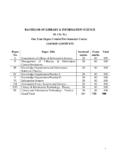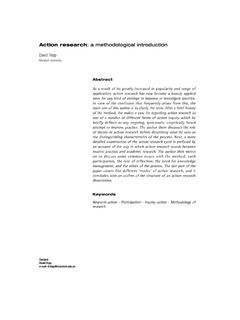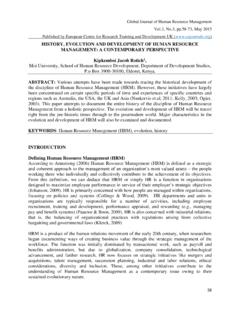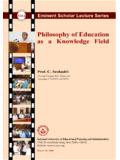Transcription of n I troducon ti to Bioethics and Ethical Decision Making
1 2. Introduction to Bioethics and Ethical Decision Making Karen L. Rich WDG Photo/Shutterstock The tiniest hair casts a shadow. Johann Wolfgang von Goethe, German poet and dramatist (1749 1832). Introduction to Bioethics The terms Bioethics and healthcare ethics sometimes are used interchange- ably. Bioethics , born out of the rapidly expanding technical environment of the 1900s, is a specific domain of ethics focused on moral issues in the field of health care (see Box 2-1). During World War II President Franklin D. Roosevelt assembled a committee to improve medical scientists' coordi- nation in addressing the medical needs of the military (Jonsen, 2000). As often happens with wartime research and advancements, the work aimed at addressing military needs also affected civilian sectors, such as the field of medicine. Between 1945 and 1965, antibiotic, antihypertensive, antipsychotic, and cancer drugs came into common medical use; surgery entered the heart and the brain; organ transplantation was initiated; and life-sustaining mechan- ical devices, the dialysis machine, the pacemaker, and the ventilator were invented.
2 (Jonsen, 2000, p. 99). OBJECTIVES. After reading this chapter, the reader should be able to do the following: 4. Discuss the history of Bioethics . 7. Identify criteria that define an Ethical dilemma. 5. Use the approach of Ethical principlism in nursing 8. Consider how critical thinking is used in Ethical practice. nursing practice. 6. Analyze bioethical issues in practice and from news 9. Use selected models of reflection and Decision media. Making in Ethical nursing practice. 33. 33 09/03/15 8:06 pm 34 Chapter 2 Introduction to Bioethics and Ethical Decision Making Box 2-1 Early Events in Bioethics August 19, 1947: The Nuremberg trials of Nazi April 14, 1975: A comatose Karen Ann Quinlan octors who conducted heinous medical experi- d was brought to Newton Memorial Hospital; she ments during World War II began. became the basis of a landmark legal case about April 25, 1953: Watson and Crick published a the removal of life support. one-page paper about DNA. July 25, 1978: Baby Louise Brown was born.
3 December 23, 1954: The first renal transplant She was the first test-tube baby. was performed. Spring 1982: Baby Doe became the basis of March 9, 1960: Chronic hemodialysis was first a landmark case that resulted in legal and eth- used. ical directives about the treatment of impaired December 3, 1967: The first heart transplant neonates. was done by Dr. Christiaan Barnard. December 1982: The first artificial heart was August 5, 1968: The definition of brain death implanted into the body of Barney Clark, who was developed by an ad hoc committee at Har- lived 112 days after the implant. vard Medical School. April 11, 1983: Newsweek published a story July 26, 1972: Revelations appeared about that a mysterious disease called AIDS was at epi- the unethical Tuskegee syphilis research. demic levels. January 22, 1973: The landmark Roe v. Wade Source: Jonsen, A. R. (2000). A short history of medical case was decided. ethics. New York, NY: Oxford University Press, pp. 99 114. However, with these advances also came increased responsibility and distress among healthcare professionals.
4 Patients who would have died in the past began to have a lingering, suffering existence. Healthcare professionals were faced with trying to decide how to allocate newly developed, scarce medical resources. During the 1950s scientists and medical professionals began meeting to discuss these confusing problems. Eventually healthcare policies and laws were enacted to address questions of who lives, who dies, and who decides. A new field of study was developed called Bioethics , a term that first appeared in the literature in 1969. (Jonsen, 1998, 2000, 2005). Ethical Principles Because shocking information surfaced about serious Ethical lapses, such as the heinous World War II Nazi medical experiments in Europe and the unethical Tuskegee research in the United States, societies around the world became par- ticularly conscious of Ethical pitfalls in conducting biomedical and behavioral research. In the United States, the National Research Act became law in 1974, 34 09/03/15 8:06 pm Ethical Principles 35.
5 Research Note: Tuskegee Syphilis Study During the late 1920s in the United States, syph- treatment for diseases other than their syphilis, ilis rates were extremely high in some areas. The and free burials. Even after penicillin was discov- private Rosenwald Foundation teamed with the ered in the 1940s, the men were not offered treat- United States Public Health Service (USPHS) to ment. In fact, the USPHS researchers arranged begin efforts to control the disease using the to keep the uninformed study participants out of drug neosalvarsan, an arsenic compound. Macon World War II because the men would be tested County, Alabama, particularly the town of Tuske- for syphilis, treated with penicillin, and lost from gee, was targeted because of its high rate of the study. The unethical research continued for syphilis, as identified through a survey. However, 40 years, from 1932 to 1972. During the 40 years of the Great Depression derailed the plans, and research, an astonishing number of articles about the private foundation withdrew from the work.
6 The study were published in medical journals and The USPHS repeated the Rosenwald survey in no attempt was made to hide the surreptitious Macon County and identified a syphilis rate of terms of the research. No one intervened to stop 22% among African American men in the county the travesty. Finally, a medical reporter learned of and a 62% rate of congenital syphilis cases. The the study and the Ethical issues were exposed. natural history (progression) of syphilis had After reading this chapter and research- not been studied yet in the United States, and ing more information on the Internet about the the surgeon general suggested that 399 African Tuskegee research, especially the contribution of American men with syphilis in Tuskegee should Nurse Evers, answer the following questions: be observed, rather than treated, and compared 1. What were the main social issues with with a group of 200 African American men who Ethical implications involved in this study? were uninfected.
7 The men were not told about the 2. Which bioethical principles were violated by particular details of their disease. They underwent the Tuskegee study? Explain. painful, nontherapeutic spinal taps to provide 3. How do various Ethical approaches relate to data about the natural history of syphilis and were the Tuskegee study? (See Chapter 1). told these procedures were treatments for bad 4. Which procedures are in place today to blood. The men were given free meals, medical prevent this type of unethical research? and a commission was created to outline principles that must be used during research involving human subjects (National Institutes of Health, 1979). In 1976, to carry out their charge, the commission held an intensive 4-day meet- ing at the Belmont Conference Center at the Smithsonian Institute. Thereafter, discussions continued until 1978, when the commission released its report called the Belmont Report. The report outlined three basic principles for all human subjects research: respect for persons, beneficence, and justice (National Institutes of Health, 1979).
8 The principle of beneficence, as set forth in the Belmont Report, is the rule 35 09/03/15 8:06 pm 36 Chapter 2 Introduction to Bioethics and Ethical Decision Making to do good. However, the description of beneficence also included the rule now commonly known as the principle of nonmaleficence that is, to do no harm. The report contained guidelines regarding how to apply the principles in research through informed consent, the assessment of risks and benefits to research partic- ipants, and the selection of research participants. In 1979, as an outgrowth of the Belmont Report, Beauchamp and Childress published the first edition of their book Principles of Biomedical Ethics, which fea- tured four bioethical principles: autonomy, nonmaleficence, beneficence, and justice. Currently the book is in its seventh edition, and the principle of auto . nomy is described as respect for autonomy. Doing ethics based on the use of principles that is, Ethical principlism . does not involve the use of a theory or a formal Decision - Making model; rather, Ethical principles provide guidelines to make justified moral decisions and to evaluate the morality of actions.
9 Ideally, when using the approach of principlism, no one principle should automatically be assumed to be superior to the other principles (Beauchamp & Childress, 2013). Each principle is considered to be prima facie binding. Some people have criticized the use of Ethical principlism because they believe it is a top-down approach that does not include allowances for the context of individual cases and stories. Critics contend that simply applying principles when Making Ethical determinations results in a linear way of doing ethics that is, the fine nuances present in relationship-based situations are not considered adequately. Nevertheless, the approach of Ethical principlism using the four prin- ciples outlined by Beauchamp and Childress (2013) has become one of the most popular tools used today for analyzing and resolving bioethical problems. Autonomy Autonomy is the freedom and ability to act in a self-determined manner. It rep- resents the right of a rational person to express personal decisions independent of outside interference and to have these decisions honored.
10 It can be argued that autonomy occupies a central place in Western healthcare ethics because of the popularity of the Enlightenment-era philosophy of Immanuel Kant. However, it is noteworthy that autonomy is not emphasized in an ethic of care and virtue ethics, and these also are popular approaches to ethics today. The principle of autonomy sometimes is described as respect for autonomy (Beauchamp & Childress, 2013). In the domain of health care, respecting a patient's autonomy includes obtaining informed consent for treatment; facil- itating and supporting patients' choices regarding treatment options; allowing 36 09/03/15 8:06 pm Autonomy 37. patients to refuse treatments; disclosing comprehensive and truthful information, diagnoses, and treatment options to patients; and maintaining privacy and confi- dentiality. Respecting autonomy also is important in less obvious situations, such as allowing home care patients to choose a tub bath versus a shower when it is safe to do so and allowing an elderly long-term care resident to choose her favor- ite foods when they are medically prescribed.
















